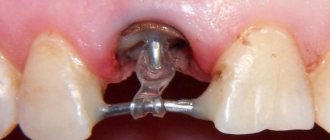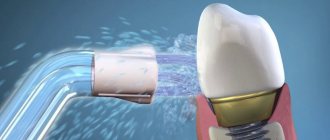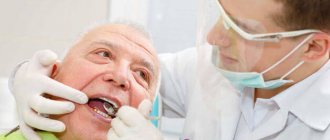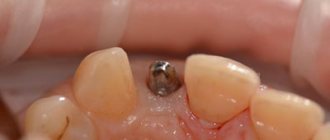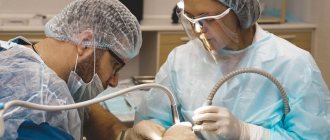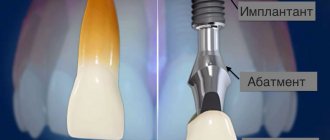The survival rate of dental implants depends on the professionalism of the doctor, the patient’s health condition and his compliance with postoperative recommendations. Rejection occurs for various reasons. Among them: installation of cheap dental systems, gum infection, porous jawbone structure. If standard conditions for implantation are observed, the risks are minimal - less than 1% . Careful preparation for the procedure and strict adherence to the doctor’s prescriptions on the part of the patient will help reduce the indicator to zero.
How does an implant normally take root?
After installation of the implant, a period of osseointegration with the jaw tissue begins, which is divided into three stages:
- Initial (3-4 weeks). Accompanied by the formation of spongy bone tissue around the implanted titanium rod. Until it is strong and has low density, chewing loads can negatively affect engraftment.
- Formation of mature bone (16-18 weeks). The spongy tissue is replaced with lamellar tissue, which completely fills the space between the implant and the areas of bone damaged during installation.
- Final (up to one and a half years). The artificial root finally fuses with the bone tissue. However, after 3-4 months on the lower jaw and 5-6 on the upper jaw, the bone acquires sufficient density. The difference in timing is due to the anatomical and physiological characteristics of bone tissue.
Signs of rejection
Swelling, pain, fever and bleeding of the gums in the first 5-7 days after implant installation are normal phenomena that go away on their own. If symptoms persist after the specified period and increase, you should urgently consult a doctor.
The failure of the implant is indicated by:
- inflammation and swelling of the gums;
- bleeding;
- strong pain;
- body temperature 38ºС and above;
- discharge of pus and unpleasant odor;
- mobility or loss of the installed structure.
Sometimes rejection occurs asymptomatically or with one of the above symptoms. Regardless of what signs appear, patients should be attentive to their own well-being. If something bothers you, contact the clinic immediately .
Related articles:
- Implant service life
- Complications during implantation
- Best Dental Implants
Causes
The implant may not take root for the following reasons:
- Peri-implantitis is an inflammation of infectious tissue around the implanted rod, leading to progressive loss of the jaw bone. It develops immediately after installation, several months and even years later. The main cause of the disease is smoking. Tobacco smoke constricts blood vessels and leads to poor circulation in the gums.
- Allergy to the construction material - titanium is biocompatible with jaw structures, but in rare cases it can cause an allergic reaction. Such situations arise if the doctor uses low-quality systems that contain impurities. In exceptional cases, when a patient is found to be allergic to titanium, zirconium oxide implants are used.
- Health problems in the patient - diabetes, immune diseases, oncology and hypertension increase the likelihood of rejection to 100%.
- Unsuitable bone structure - with a porous bone structure, even with sufficient volume, the implant will not hold. To prevent this, the bone is additionally strengthened with special material.
- Violation of the osseointegration process occurs due to the installation of cheap systems, the components of which, when in contact with the jaw structures, provoke the growth of scar tissue rather than bone. As a result, fibrosis develops and the structure falls out.
In our Center, the listed points are excluded. We work only with reliable, time-tested implants from Nobel Biocare (Switzerland). Before the procedure, we carefully examine the patient to identify the characteristics of the dentofacial apparatus and possible contraindications. We perform implantation after eliminating risks and provide a guarantee for treatment.
Complications during surgery
Due to the fault of the implantologist:
- Infection of the hole due to insufficient sterility of instruments;
- incorrect selection of pin;
- violation of the rules of preoperative preparation;
- installing an implant on insufficiently dense bone, refusing bone grafting and sinus lifting;
- injury or overheating of the bone;
- violation of sterility;
- ignoring contraindications.
Damage to the maxillary sinuses
Injury to the maxillary sinus can occur due to erroneous determination of the height of the alveolar process or too much pressure on the instrument. In this case, the implant is removed and drug treatment is carried out. The next attempt at implantation is carried out no earlier than 6 months later.
Damage to the mandibular nerve
The risk of damage increases when implanted above the mandibular canal, in cases where the bone is not dense enough. In this case, bone grafting (tissue augmentation) is first performed. The injury can cause facial numbness and drooling from the mouth.
How it happens at different times
Express rejection
Occurs with a coarse porous bone structure. This feature makes it impossible to create a reliable support for the titanium root - the bone is not able to provide the implant with the necessary fastening and nutrition, and cannot provide sufficient tension to hold the implant. Problems in this case can be avoided with the help of growth stimulants (morphogenetic proteins), which are attached to the neck of the implant and activate the growth and compaction of the surrounding bone mass.
Also among the common causes of early rejection:
- premature loading of the implant with a crown at the time of engraftment during express implantation;
- infection of the jaw tissue when installing an implant immediately after tooth extraction with inflammation at the root.
Deferred period
Usually, if rejection does not occur a month after implantation, then osseointegration took place without complications. However, there are cases of later rejection when crowns were installed on the implant and everything looks fine. Among the reasons:
- Prosthetic errors occur when the angular chewing load on the titanium root is increased. It manifests itself as pain when chewing and redness of the gums.
- Inflammation of the tissues in the implant area due to a bacterial process that develops due to the accumulation of food debris between the teeth. It may be asymptomatic at first, but over time it is accompanied by bleeding gums - it looks inflamed, swollen, like periodontal disease. After a year or two, this condition leads to the structure falling out.
Oral care
After installation of implants
You should not brush your teeth for several days after installing titanium roots. The mucous membrane is very sensitive during this period, and there is a high probability of damage to the sutures. You need to rinse your mouth with infusions of medicinal herbs and antiseptic solutions. This will protect the oral cavity from bacteria, relieve swelling and inflammation.
During the rehabilitation period
You can start using a soft toothbrush. Cleaning should be done carefully, avoiding the wound surface. To get rid of food debris, you need to rinse your mouth after eating.
After the implants have taken root
Rules for caring for titanium structures:
- Brush your teeth as usual with a brush and toothpaste. Artificial crowns require no less care than regular teeth. For more thorough cleaning of interdental spaces and crowns, you can use an irrigator.
- Rinse your mouth every time after eating.
- Carry out regular dental checkups. At an early stage, the doctor can detect inflammation of the tissues around the implant and detect gaps in the prostheses.
How often does it occur - what is the percentage of rejection?
Implant failure is an extremely rare occurrence and should not be a concern for patients. According to statistics, it occurs in 1-2% of cases. When installing brands popular on the world market (Nobel Biocare, Astra Tech, Straumann), the figure is even lower, amounting to 0.2-0.5%. These manufacturing companies carefully examine each case of rejection and eliminate negative factors. Professional clinics using original products and installation protocols guarantee a survival rate of 99%.
Levin Dmitry Valerievich
Chief physician, Ph.D.
What does the doctor do if symptoms appear?
If signs of implant failure appear, the patient should contact the clinic. The measures taken are determined by the doctor based on an examination of the installed implant and X-ray data.
The tactics for eliminating symptoms are individual in each clinical case:
- After installing the titanium root, bad breath appeared. The cap screw is unscrewed from the titanium rod, cleaned and put in place.
- Inflammation affects periodontal tissues without going beyond them . The gum is opened, the affected area is cleaned and disinfected. Antibiotics are prescribed.
- The source of infection spreads to the bone . The degree of bone destruction is determined. After stopping the inflammatory process and removing necrotic tissue, bone grafting is performed (directed bone regeneration using protective membranes).
- Severe tissue damage accompanied by bone recession was diagnosed. A decision is made to remove the structure.
Treatment
After implantation, the condition of the oral cavity and the healing process must be monitored by the implantologist (for this purpose a control visit is carried out), and the patient himself. Experts advise paying attention to symptoms during the rehabilitation period. It must be remembered that rejection of the artificial root can occur even after several months, since the engraftment period takes up to 6 months.
If pathological symptoms occur, you must immediately contact the specialist who performed the operation. As a rule, if the implant is not accepted by the body, an inflammatory process begins. The longer the complication progresses, the more difficult it is to further treat.
Before unscrewing the implant, the doctor may order diagnostics (x-rays). Based on the results of the examination, a decision is made on the need to remove the prosthesis.
Treatment methods:
- opening the gums to cleanse the cavity of pus;
- unscrewing the plug from the implant for cleaning;
- complete removal of the implant.
For any type of complications accompanied by an inflammatory process, antiseptic treatment of the area where the prosthesis is installed and antibiotics are necessary. In each case, the treatment method is determined individually.
Is it possible to re-implant after implant failure?
In most clinical cases, re-installation of the implant is possible, but only after eliminating the infection and restoring damaged tissue. If there are no contraindications, implantation is carried out 1-2 months after removal of the unaccustomed structure. If the jaw bone remains unloaded longer, the atrophic process begins .
The final decision is made depending on the reason for rejection. If the cause is a chronic disease or the body’s reaction to a foreign body, repeated attempts will not yield results. It is better to choose another method of restoring missing teeth. If the patient does not want to quit smoking, there is no point in repeating the procedure.
Content
- Symptoms
- Why implants don't take root
- Protect yourself from problems
Implantation is a complex procedure that requires skilled execution. During the healing period, swelling may form and pain may be felt, because the jawbone and gums are injured. Bleeding is possible. For surgical intervention, these consequences are normal and disappear within a few days.
There are also more complex consequences. Implant rejection is the most unpleasant of them all.
What to do to prevent the situation
- The risks are minimal when dental restoration surgery is performed by an experienced doctor in a well-equipped clinic. Large Centers do not skimp on equipment and staff training. When choosing a dentist, you can rely on reviews from patients who have already undergone treatment there.
- Go through a full examination, tell the doctor about all your health problems, without hiding anything.
- When choosing implants, you should not save money; in this situation, the price is proportional to the quality. Popular brands have more guarantees and fewer risks.
- Follow the doctor's recommendations in the postoperative period, including giving up bad habits.
What do we do to avoid unpleasant consequences?
We install Nobel Biocare implants
Produced by the Swiss company of the same name. The survival rate is 99.3% - the highest rate in dental implantology. They solve any edentulous problems, even against the background of acute jaw bone deficiency. They have their own markings to protect against counterfeiting. Equipped with a patented micro-structured porous surface TI-Unite, which accelerates the osseointegration of the rod with the jaw tissue and activates regeneration processes. Nobel implants have a lifetime warranty.
We exclude contraindications
Before implantation, it is important to exclude the patient from diseases that could negatively affect the implant’s healing. Among them: blood diseases, uncompensated diabetes mellitus, pathologies of the immune system, oncology. To identify health problems, the patient is prescribed blood tests, computed tomography, and, if necessary, consultations with other specialists, such as a cardiologist, endocrinologist, phlebologist, or ENT specialist. In our Center, during the period of implantological treatment, correction of chronic diseases is carried out, and a full-time ENT doctor also conducts consultations.
We develop a treatment plan
Planning is an important step in preparing for surgery. Provides for the selection of implant models, their location in the jaw, taking into account the anatomical features of the dentofacial apparatus and the condition of the bone. Our Center performs computer modeling to ensure surgical accuracy, reduce the likelihood of complications and predict treatment results.
We maintain sterility
This is the main condition for successful implantation. During the procedure, the doctor uses only clean instruments and uses antiseptics to disinfect the oral cavity. Each implant is packaged in a sterile box, which is opened immediately before installation. The risk of infection is zero.
We act according to installation protocols
Our doctors were trained in the most modern high-tech training centers. They are fluent in advanced treatment methods and successfully apply them in practice. We use only original components and installation protocols that speed up engraftment.
We take action in a timely manner
The rehabilitation period is constantly monitored by a doctor. We invite patients for examinations, give recommendations on caring for the installed structure, nutrition, and lifestyle. The doctor is on call around the clock if the patient has any questions about treatment.
Recommendations
Implant failure is rare, but you can reduce the likelihood of such a problem to a minimum if you read and adhere to the recommendations before implantation.
Advice from implantologists:
- select the clinic and doctor with special care (read the clinic’s documentation and reviews);
- undergo a preliminary examination and, if necessary, treat pathologies that are a contraindication to surgery;
- strengthen your gums before and after implantation;
- do not hide the presence of contraindications from the specialist;
- follow your doctor's recommendations;
- do not violate the rules of oral hygiene.
Preparation for the procedure for implantation and further oral care is the best prevention of negative consequences.
